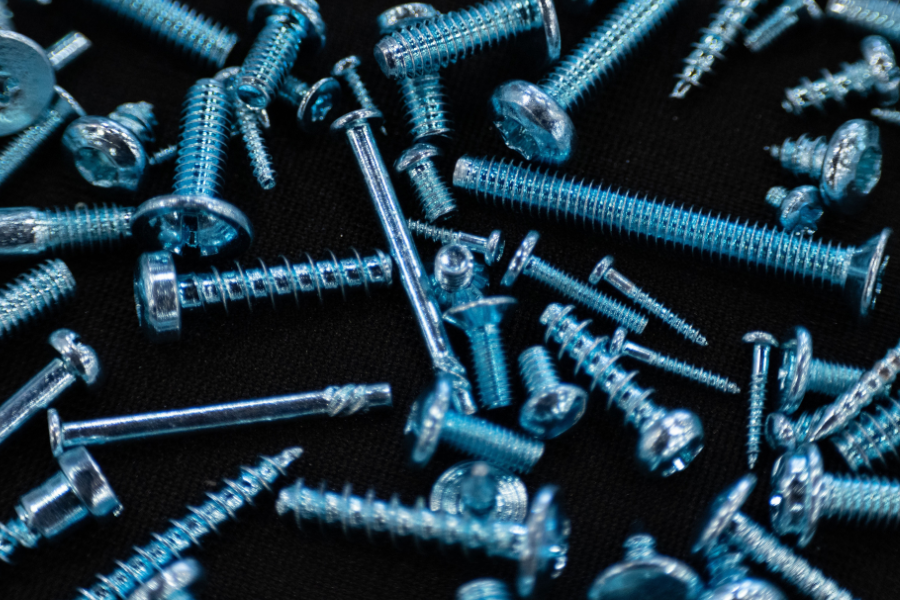Every issue of Fastener Technology International (FTI) magazine, www.fastenertech.com, contains an article summarizing fastener-related patents that have been recently awarded by the United States Patent Office (USPTO), www.uspto.gov. Here are excerpts from FTI’s latest “USPTO Fastener Patents” article:
Concrete Fastener, US Patent 11739783, Invented by Joel Houck, and assigned to Simpson Strong-Tie Company Inc.
A fastener includes a shank having a first end and a second end defining a length. The fastener includes a thread provided on the shank, the thread  including a first region adjacent to the first end and a second region between the first region and a head at the second end, the thread includes a leading edge and a trailing edge, each edge forming an angle with a surface of the shank, the leading edge forming a non-normal angle with the surface of the shank and the trailing edge forming an angle about normal to the surface of the shank. The fastener may include an arcuate detent region in the shank between respective turns of the thread, the detent region having a length, the length decreasing from the first end toward the second end between the respective turns. The fastener may include a plurality of flutes positioned along a length of the shank.
including a first region adjacent to the first end and a second region between the first region and a head at the second end, the thread includes a leading edge and a trailing edge, each edge forming an angle with a surface of the shank, the leading edge forming a non-normal angle with the surface of the shank and the trailing edge forming an angle about normal to the surface of the shank. The fastener may include an arcuate detent region in the shank between respective turns of the thread, the detent region having a length, the length decreasing from the first end toward the second end between the respective turns. The fastener may include a plurality of flutes positioned along a length of the shank.
Clinch Fastener with a Spiral Shank, US Patent 11703076, invented by Qiang Sun, Dapeng Duan and Larry Zhang, and assigned to Penn Engineering & Manufacturing Corp.
A press-in fastener has from top to bottom: a head, a clinch feature, and a spiral, knurled shank. The fastener can hold two parts together by first clinching with a first metal panel, and then being pressed into a hole in a second, less ductile panel having a uniform interference between the knurled fastener shank and the hole. The knurled shank has a helix configuration that allows for use in nonductile materials and eliminates the need for tapered holes and screws for applications that do not require disassembly.
with a first metal panel, and then being pressed into a hole in a second, less ductile panel having a uniform interference between the knurled fastener shank and the hole. The knurled shank has a helix configuration that allows for use in nonductile materials and eliminates the need for tapered holes and screws for applications that do not require disassembly.
Straight Shank End Screw for Foreign-Object-Debris (FOD) Reduction, US Patent 11732744, invented by John C. Osborne and Terrence C. Seet, and assigned to The Boeing Company
A fastener which includes a first portion of a shaft which defines threads, and a second portion of the shaft, which extends from the first portion of the shaft, includes a planar curved surface. A method for securing a fastener to an e-nut, which includes the step of inserting the fastener positioned within an e-nut into an opening defined by and which extends through at least two components to be secured together, wherein: a first portion of the shaft of the fastener defines threads; and a second portion of the shaft of the fastener, which extends from the first portion of the shaft, defines a curved planar surface.
includes a planar curved surface. A method for securing a fastener to an e-nut, which includes the step of inserting the fastener positioned within an e-nut into an opening defined by and which extends through at least two components to be secured together, wherein: a first portion of the shaft of the fastener defines threads; and a second portion of the shaft of the fastener, which extends from the first portion of the shaft, defines a curved planar surface.
Visit www.fastenertech.com to see the entire article in the October/November 2023 issue of FTI, pages 68-71. And for even more patented fasteners and fastener-making equipment and tools, visit the International Fastener Expo 2023 (IFE 2023) in Las Vegas, NV, USA. And before you go, check out the same issue of FTI for an IFE 2023 preview article on pages 76-86, IFE 2023 exhibitor spotlights on pages 146-153 and dozens of exhibitor advertisements throughout the entire issue.








